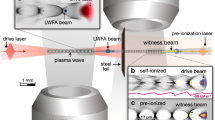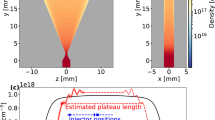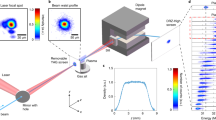Abstract
Plasma waves generated in the wake of intense, relativistic laser1,2 or particle beams3,4 can accelerate electron bunches to gigaelectronvolt energies in centimetre-scale distances. This allows the realization of compact accelerators with emerging applications ranging from modern light sources such as the free-electron laser to energy frontier lepton colliders. In a plasma wakefield accelerator, such multi-gigavolt-per-metre wakefields can accelerate witness electron bunches that are either externally injected5,6 or captured from the background plasma7,8. Here we demonstrate optically triggered injection9,10,11 and acceleration of electron bunches, generated in a multi-component hydrogen and helium plasma employing a spatially aligned and synchronized laser pulse. This ‘plasma photocathode’ decouples injection from wake excitation by liberating tunnel-ionized helium electrons directly inside the plasma cavity, where these cold electrons are then rapidly boosted to relativistic velocities. The injection regime can be accessed via optical11 density down-ramp injection12,13,14,15,16 and is an important step towards the generation of electron beams with unprecedented low transverse emittance, high current and 6D-brightness17. This experimental path opens numerous prospects for transformative plasma wakefield accelerator applications based on ultrahigh-brightness beams.
This is a preview of subscription content, access via your institution
Access options
Access Nature and 54 other Nature Portfolio journals
Get Nature+, our best-value online-access subscription
$29.99 / 30 days
cancel any time
Subscribe to this journal
Receive 12 print issues and online access
$209.00 per year
only $17.42 per issue
Buy this article
- Purchase on Springer Link
- Instant access to full article PDF
Prices may be subject to local taxes which are calculated during checkout




Similar content being viewed by others
Data availability
The data that support the plots within this paper and other findings of this study are available from the corresponding author upon reasonable request.
References
Tajima, T. & Dawson, J. M. Laser electron accelerator. Phys. Rev. Lett. 43, 267–270 (1979).
Leemans, W. P. et al. Multi-GeV electron beams from capillary-discharge-guided subpetawatt laser pulses in the self-trapping regime. Phys. Rev. Lett. 113, 245002 (2014).
Chen, P., Dawson, J. M., Huff, R. W. & Katsouleas, T. Acceleration of electrons by the interaction of a bunched electron beam with a plasma. Phys. Rev. Lett. 54, 693–696 (1985).
Blumenfeld, I. et al. Energy doubling of 42 GeV electrons in a metre-scale plasma wakefield accelerator. Nature 445, 741–744 (2007).
Rosenzweig, J. B. et al. Experimental observation of plasma wake-field acceleration. Phys. Rev. Lett. 61, 98–101 (1988).
Litos, M. et al. High-efficiency acceleration of an electron beam in a plasma wakefield accelerator. Nature 515, 92–95 (2014).
Oz, E. et al. Ionization-induced electron trapping in ultrarelativistic plasma wakes. Phys. Rev. Lett. 98, 084801 (2007).
Vafaei-Najafabadi, N. et al. Beam loading by distributed injection of electrons in a plasma wakefield accelerator. Phys. Rev. Lett. 112, 025001 (2014).
Hidding, B. et al. Ultracold electron bunch generation via plasma photocathode emission and acceleration in a beam-driven plasma blowout. Phys. Rev. Lett. 108, 035001 (2012).
Li, F. et al. Generating high-brightness electron beams via ionization injection by transverse colliding lasers in a plasma-wakefield accelerator. Phys. Rev. Lett. 111, 015003 (2013).
Wittig, G. et al. Optical plasma torch electron bunch generation in plasma wakefield accelerators. Phys. Rev. ST Accel. Beams 18, 081304 (2015).
Bulanov, S., Naumova, N., Pegoraro, F. & Sakai, J. Particle injection into the wave acceleration phase due to nonlinear wake wave breaking. Phys. Rev. E 58, 5257–5260 (1998).
Suk, H., Barov, N., Rosenzweig, J. B. & Esarey, E. Plasma electron trapping and acceleration in a plasma wake field using a density transition. Phys. Rev. Lett. 86, 1011–1014 (2001).
Geddes, C. G. et al. Plasma-density-gradient injection of low absolute-momentum-spread electron bunches. Phys. Rev. Lett. 100, 215004 (2008).
Faure, J. et al. Injection and acceleration of quasimonoenergetic relativistic electron beams using density gradients at the edges of a plasma channel. Phys. Plasmas 17, 083107 (2010).
Brijesh, P. et al. Tuning the electron energy by controlling the density perturbation position in laser plasma accelerators. Phys. Plasmas 19, 063104 (2012).
Manahan, G. G. et al. Single-stage plasma-based correlated energy spread compensation for ultrahigh 6D brightness electron beams. Nat. Commun. 8, 15705 (2017).
Bostedt, C. et al. Linac coherent light source: the first five years. Rev. Mod. Phys. 88, 015007 (2016).
Rosenzweig, J. B. & Colby, E. Charge and wavelength scaling of RF photoinjector designs. AIP Conf. Proc. 335, 724–737 (1995).
Hogan, M. J. et al. Plasma wakefield acceleration experiments at FACET. New J. Phys. 12, 055030 (2010).
Davidson, N., Friesem, A. A. & Hasman, E. Holographic axilens: high resolution and long focal depth. Opt. Lett. 16, 523–525 (1991).
Green, S. Z. et al. Laser ionized preformed plasma at FACET. Plasma Phys. Control. Fusion 56, 084011 (2014).
Manahan, G. G. et al. Hot spots and dark current in advanced plasma wakefield accelerators. Phys. Rev. Accel. Beams 19, 011303 (2016).
Ammosov, M. V., Delone, N. B. & Krainov, V. P. Tunnel ionization of complex atoms and atomic ions in a varying electromagnetic-field. Sov. Phys. JETP 64, 1191–1194 (1986).
Pak, A. et al. Injection and trapping of tunnel-ionized electrons into laser-produced wakes. Phys. Rev. Lett. 104, 025003 (2010).
Umstadter, D. et al. Laser injection of ultrashort electron pulses into wakefield plasma waves. Phys. Rev. Lett. 76, 2073–2076 (1996).
Faure, J. et al. Controlled injection and acceleration of electrons in plasma. Nature 444, 737–739 (2006).
Thomas, A. G. R. et al. Monoenergetic electronic beam production using dual collinear laser pulses. Phys. Rev. Lett. 100, 255002 (2008).
Bourgeois, N., Cowley, J. & Hooker, S. M. Two-pulse ionization injection into quasilinear laser wakefields. Phys. Rev. Lett. 111, 155004 (2013).
Yu, L.-L. et al. Two-color laser-ionization injection. Phys. Rev. Lett. 112, 125001 (2014).
Tomassini, P. et al. The resonant multi-pulse ionization injection. Phys. Plasmas 24, 103120 (2017).
Chao, A. W. Handbook of Accelerator Physics and Engineering 2nd edn (World Scientific, 2013).
Nieter, C. & Cary, J. R. VORPAL: a versatile plasma simulation code. J. Comput. Phys. 196, 448–473 (2004).
Bruhwiler, D. L. et al. Particle-in-cell simulations of tunneling ionization effects in plasma-based accelerators. Phys. Plasmas 10, 2022–2030 (2003).
Chen, M. et al. Numerical modeling of laser tunneling ionization in explicit particle-in-cell codes. J. Comput. Phys. 236, 220–228 (2013).
Acknowledgements
The FACET ‘E210: Trojan Horse’ plasma wakefield acceleration experiment was built and operated with support from UCLA (US Department of Energy (DOE) contract no. DE-SC0009914), RadiaBeam Technologies (DOE contract no. DE-SC0009533), the FACET E200 team and DOE under contract no. DE-AC02-76SF00515, H2020 EuPRAXIA (grant no. 653782), Helmholtz VH-VI-503, EPSRC (grant no. EP/N028694/1) and the Research Council of Norway (grant no. 230450). R.Z. and M.C.D. acknowledge support from DOE grant no. DE-SC0011617 and US NSF grant no. PHY-1734319. B.H. acknowledges support from the DFG Emmy–Noether programme. This work used computational resources of the National Energy Research Scientific Computing Center, which is supported by DOE DE-AC02-05CH11231, JURECA (project hhh36), HLRN and Shaheen (project k1191). D.L.B. acknowledges support from the US DOE Office of High Energy Physics under award no. DE-SC0013855. J.R.C. acknowledges support from the National Science Foundation under award no. PHY 1734281.
Author information
Authors and Affiliations
Contributions
B.H., J.B.R., G.A., M.J.H. and V.Y. planned the project. A.D., O.S.K., T.H., A.K., P.S., G.G.M., Y.X., M.D.L., B.D.O., S.G., C.I.C., S.Z.G., C.A.L., E.A., R.Z., M.C.D., G.A., A.M., M.J.H., V.Y., J.B.R. and B.H. contributed to the experiments. O.S.K., T.H., A.K., P.S., G.G.M., A.B., D.U., G.W., A.F.H., Y.X., M.D.L., B.D.O., C.A.L., D.L.B., J.R.C. and B.H. contributed to numerical and simulation work. All authors contributed to writing the manuscript.
Corresponding author
Ethics declarations
Competing interests
G.A., A.M., D.L.B. and J.R.C.’s primary or secondary affiliations are with companies who supported the experimental and computational work, and a patent has been filed based on related work17 (PCT/GB2017/052942) by the University of Strathclyde, supported by RadiaBeam Technologies.
Additional information
Publisher’s note: Springer Nature remains neutral with regard to jurisdictional claims in published maps and institutional affiliations.
Supplementary information
Supplementary Information
Supplementary discussion, Supplementary Figs. 1–4 and Supplementary Information on Supplementary videos.
Supplementary Video 1
Particle-in-cell simulation video of electron bunch generation from plasma torch injection with a laser pulse energy of 5 mJ.
Supplementary Video 2
Particle-in-cell simulation video of electron bunch generation from plasma photocathode injection with a laser pulse energy of 0.5 mJ.
Rights and permissions
About this article
Cite this article
Deng, A., Karger, O.S., Heinemann, T. et al. Generation and acceleration of electron bunches from a plasma photocathode. Nat. Phys. 15, 1156–1160 (2019). https://doi.org/10.1038/s41567-019-0610-9
Received:
Accepted:
Published:
Issue Date:
DOI: https://doi.org/10.1038/s41567-019-0610-9
This article is cited by
-
Attosecond-Angstrom free-electron-laser towards the cold beam limit
Nature Communications (2023)
-
Free-electron lasing with compact beam-driven plasma wakefield accelerator
Nature (2022)
-
Cascaded particle accelerators reach new energy
Nature Photonics (2021)
-
Energy spread minimization in a beam-driven plasma wakefield accelerator
Nature Physics (2021)
-
Demonstration of a compact plasma accelerator powered by laser-accelerated electron beams
Nature Communications (2021)



